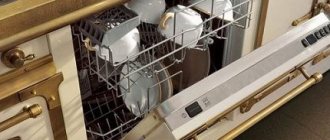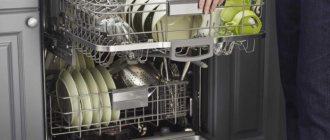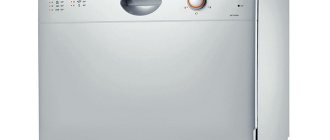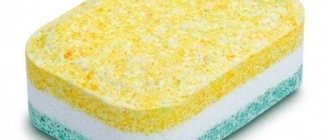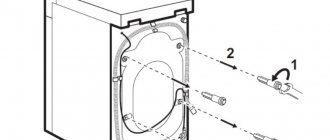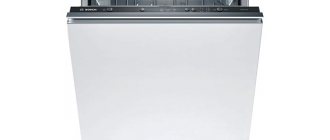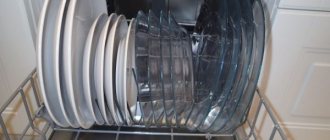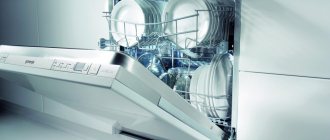Such a useful purchase as a Bosch dishwasher greatly simplifies housekeeping and ensures economical water consumption. You can install the equipment by a service center technician or yourself, strictly following the manufacturer’s recommendations. But it is equally important to use the Bosch dishwasher correctly.
- Installing a Bosch dishwasher
- How to turn it on
- First use of the dishwasher
- Control panel and modes
- Required funds
- Care for PMM
- Bosch dishwasher catalog with reviews
Instructions on how to use a Bosch dishwasher
This is exactly how the name Silence plus of the Bosch dishwasher series sounds when translated into Russian. An inverter-type engine, a pump made on the basis of the latest technical advances, all this, together with an improved noise insulation system, make the operation of machines of this model completely inaudible. What makes the Bosch SMS40I08RU dishwasher (a specific example of a machine) stand out in a long line of similar appliances from competing manufacturers.
Bosch dishwasher
Related article: How to remove the drain hose from a dishwasher
Why do you need an idle start?
Most owners of new household appliances in the kitchen imagine the first launch of a Bosch dishwasher with full compartments of dishes, which they may have been specially saving for the last week in order to experience in practice all the advantages of owning a unit.
But in the instructions, German manufacturers recommend that the first start-up should be done idle, that is, with detergents, but without loading dishes. This is necessary for:
- Removing lubricant residues, small particles of packaging and other elements that have fallen into the internal cavity of the dishwasher.
- A closer acquaintance with the operation of the device to see how it draws water, sprays, how quickly cycles change and drying occurs. Having seen this process without internal objects, some better understand the principle of operation and how to arrange the dishes inside.
- Make sure that household appliances are in working order and quickly notice the location of the breakdown if something does not work.
Decoding the letters of the SPV and SMS models
It’s not difficult to figure this out if you know how the letters in the name of the purchased model are correctly deciphered. In these abbreviations, these letter symbols mean:
- S - spueler (rinsing), in the case of the first character in the spelling;
- P – Means a width of 45 cm (narrow, new generation) and M – standard width (60 centimeters), also a new generation. With the option of a second character in the name of the dishwasher model.
- The letter V indicates that this model is built-in with an open access panel. S – on the contrary, speaks of a free-standing device.
Choosing the right program
The first question that inexperienced users have is which cleaning mode to choose for washing dishes. Modern units, as a rule, have in their arsenal several programs designed for certain situations.
How to wash lightly soiled dishes:
- The quick wash program is sufficient for washing plates and cups that are not too dirty.
- It is better to choose a delicate sink for glass or crystal items that are too fragile.
Washing heavily soiled dishes
- The right washing mode will help you clean your dishes to a crystal shine.
The pre-wash mode prevents food residues from drying out on plates that wait until the dishwasher is fully loaded.
- Extremely dirty items or dishes with residual grease should be pre-soaked. After it, the cleansing process will be of better quality.
- If soaking does not help, you can use the “Very Dirty” function, which is also present in many modern models. Cyclic washing will help clean dishes until they shine.
A well-chosen program will make dishwashing more efficient with minimal consumption of water and dishwashing detergents.
Features of the Bosch series - silence plus
The main distinguishing feature, as already mentioned, is the almost silent operation of the machines in this series. Which is very important when living in a small apartment, taking into account the fact that they use (the dishwasher) mainly at night, loading it with dirty dishes that have accumulated during the day (evening).
Bosch dishwasher
A distinctive innovation also includes the increased safety of the machine; the door is equipped with a child protection function, that is, against changing the set washing program and opening the machine door during operation. The non-full load function allows you to avoid waiting for the accumulation of dishes that need to be washed, by using a touch sensor to determine the number of cutlery and the volume of water needed to wash it. Thereby saving time, electricity needed for heating and the water supply itself. It is worth noting the presence of a double rocker for washing hard-to-reach places of dishes (which was not present in earlier models) and five directions of jets of water and washing liquids supplied under pressure. Height-adjustable upper box of the Bosch dishwasher, freeing up space in its lower compartment for large items (pans, pots, etc.).
How to load dishes correctly?
Proper loading of dishes into the dishwasher allows you to avoid problems that may arise for novice users of this equipment:
- high-quality result - thanks to proper arrangement and maintaining the distance between objects;
- prevention of accidental damage - when everything is in place and fixed with holders, the risk of breaking a glass or plate in the process is minimal;
- the maximum number of dishes washed per cycle - arranging according to the recommendations will save resources and wash the optimal amount of dishes, because more will fit into the compartment than with a chaotic arrangement.
There are compartments in the dishwasher (usually 3 of them) designed specifically to accommodate certain products:
- cutlery tray;
- upper smaller compartment;
- the bottom one is for large dishes.
Upper compartment
The top tray holds dinner and dessert plates, mugs, glasses and wine glasses - all fragile dishes that are used most often. For ease of placement, there are dividers and fasteners - this way you can maintain the necessary gaps between the plates and secure them from unwanted damage.
You can also place plastic bowls and containers here that are machine washable. This way the dishes will be further away from the hot streams of water and the heating element.
Mugs, deep bowls and wine glasses are placed upside down for better cleaning of the inner surface.
Lower basket
Large utensils and heavily soiled plates, pots and molds are placed here. The principle of arrangement is identical: bottom up, large objects at the edges, smaller ones in the center. Large frying pans, if they can be washed in the dishwasher, are placed vertically, after removing the removable handles. If the handle cannot be removed, then position it so that it does not interfere with the sprinkler during operation.
It is better to wash large pots separately from the entire set, because... They take up a lot of space, which affects the quality of cleaning of nearby items.
Removable tray
A removable tray or pull-out cutlery basket is located at the very top and is designed for washing forks, spoons and other small kitchen utensils.
In Bosch dishwashers, the cutlery tray has the form of a basket with compartments where several sets can be placed horizontally, and large ladles and skimmers are placed on special folding shelves.
Some types of PMMs have vertical trays where devices should be placed with the handle facing up for more efficient washing. Don’t forget about the required distance between forks and spoons if there are no specialized compartments.
User instructions for using the dishwasher
There are no changes in the installation, use and care of the Bosch Silence plus series dishwasher, models SPV and SMS, that are different from other devices of the same purpose.
Article on the topic: Which vacuum cleaner with a bag or container to choose
Instructions on how to use a Bosch dishwasher, after connecting it to water supply, electricity and grounding, consist of the following steps:
- Before turning on the machine for the first time, the settings program determines the type of detergent used (gel, powder, tablet) and its direct loading into a specially designated container.
- The same steps in the same sequence are performed with rinse aids for clean dishes.
- Loading, correct dosage of regenerating salts.
- Test placement of dishes on the shelves of different compartments (upper, lower) in various combinations of dishes.
- Closing the door and turning on the water supply to the machine with a preliminary selection of the automatic washing program: intensive, medium or light. Comparison of the obtained washing result with the quality declared by the device manufacturer
- Carry out similar operations with all functions (delay timer, partial load function, etc.) and capabilities of the machine model.
Upon completion of all checks, you should note that when you open the washing compartment immediately after the dishwasher has finished operating, hot steam is released. If you have additional questions, you should carefully re-read the instructions for installing, connecting and using the device you purchased.
An incorrectly installed and connected dishwasher will automatically lead to disruption of the operation and performance of its immediate functions. If you cannot solve the problem yourself, you should contact the company’s service center or use the services of a professional technician.
Video instruction for user
How to properly use a Bosch dishwasher is described in detail in the instructions supplied with each Bosch brand appliance. For visual perception and understanding of the actions being carried out, you can watch the video.
Article on the topic: Is it possible to store a thermos in the refrigerator?
How to turn it on
Many manufacturers, including Bosch, recommend conducting a dry test run of a new dishwasher. This action helps:
- remove any remaining grease and dust from the device parts;
- evaluate the correct installation and operation of the equipment.
In addition, if problems are identified, you will not have to remove unwashed dishes from the machine.
compartment for PMM products
The washing chamber should be empty, but you will need to use detergent and special salt from the starter kit. The salt compartment is located in the pull-out lower basket at the bottom of the machine.
After unscrewing the lid, add 2/3 of the contents of the pack. The reservoir must not be overfilled.
Then, on the inside surface of the dishwasher door, find compartments for products: powder, gel or tablets.
Now you can turn on the machine and set the type of detergent used on the panel. Salt consumption depends on the water hardness level specified by the user.
Is a dishwasher profitable?
Oh yes! No
Bosch devices come with test strips for determining this indicator. If you do not soften the water with salt, the walls of the chamber will quickly become covered with scale.
All that remains is to select any operating mode and press the “Start” button. Don't forget to open the water tap.
Universal operating instructions for Bosch dishwashers
Bosch appliances top the ratings of the most reliable and high-quality household appliances.
Thanks to this, the majority of consumers vote for it, even despite a large number of competitors and a fairly high price. Dishwashers also have a number of advantages over other manufacturers, wider functionality and a longer service life. When buying a Bosch dishwasher, many people get lost or don’t want to read the thick operating instructions. They are often difficult to understand due to complex technical language or not published in Russian. We will tell you in this article how to save your time and get to know this necessary unit better, and avoid mistakes in operating the machine. The manufacturer has a huge fleet of models, with functions for every taste, built-in and free-standing, with a width of 45-60 cm. Structurally and according to the principle of operation, they are approximately the same, so you can safely apply all the recommendations indicated to your machine.
- Operating instructions for Bosch dishwashers
- The first launch is the most important!
- Rules for loading dishwashers efficiently
- Selection of detergents
- Introduction to the basic programs of Bosch dishwashers
- Secrets of caring for Bosch dishwashers
- The meaning of the error code and possible problems
Detergents and auxiliaries
Dishwashers use a whole range of detergents and additional products:
- detergent;
- salt;
- rinse aid
The form of release of funds varies:
- powder;
- liquid;
- pills;
- capsules.
Washing components can be sold either individually or as a 3-in-1 universal product.
The former are easy to dose and are convenient for short periods because they dissolve faster. Capsules and tablets are more convenient to use because they do not fall apart or crumble. Manufacturers prefer to use tablets because they are easier to load. Some species have a shell that itself dissolves in water. The most famous manufacturers of detergents are Finish, Fairy, Somat.
One of the most common causes of device failure is the formation of scale on parts. In order to prevent this, special salt is used. Dishwasher rinse aid is also important. It makes dishes more sparkling, removes remaining foam, quickly dries the surface, and prevents stains and streaks.
The first product developed for PMM was powder. It is not considered the best today, but is still popular. Its advantages are availability, low cost, efficiency, and rapid dissolution. The disadvantages are that dosing the powder is difficult. There is little salt in the composition, so it must be used. Some powders do not contain rinse aid, so they may leave streaks.
The most preferable option is a liquid product. Its active particles prevent scale formation and effectively soften water. The liquid contains no abrasive particles, so it can be used for delicate dishes. It dissolves well and copes well with stains of varying complexity. Safe for people with high sensitivity and allergies. The step-by-step instructions for the products describe in detail how to use Finish and other brands of dishwashers.
Operating instructions for Bosch dishwashers
On the facade of the dishwasher there is a control unit with a power button, keys for selecting modes, additional settings and an electronic display. Modern machines have up to ten different programs. Also, some machines are equipped with LEDs to inform you about the end of the mode, lack of detergents, high water hardness, possible leakage or water shutdown. Each program has its own intuitive icon and numerical value.
The first launch is the most important!
The first start after purchasing a dishwasher is a strategically important moment! Never neglect this step, otherwise you can significantly reduce the life of the machine. The first use should be idle, that is, without dishes and detergents at maximum temperature. This is necessary in order to check the correct installation, the presence of leaks, extraneous sounds during operation, and also to wash off factory lubricants and dust.
Article on the topic: How to remove a dent on a washing machine
The manufacturer often includes test strips in the package to determine water hardness. It is necessary to measure the water before starting and, based on this, add softening salt to a special compartment. This salt is necessary for the normal functioning of the machine and should always be available. Otherwise, if you do not use it, unsightly whitish stains will remain on the dishes, and scale can damage the heating elements.
The dishwasher adds salt when washing itself; you just need to constantly monitor its level. At the first start, water is added to the salt compartment; this will not be required in the future.
Rules for loading dishwashers efficiently
To effectively clean dishes, you need to load the machine correctly.
Simple rules will help you achieve ideal cleanliness of dishes and increase the service life of your Bosch dishwasher:
- Avoid overfilling and preventing the circulation of water and detergents.
- Start loading the machine from the bottom up. First, plates and dishes are set up.
- Mugs and bowls are placed on the top level. Glasses, glasses and other fragile dishes are secured with folding holders.
- Spoons, forks, and spatulas are placed vertically with the handle down. The knives are opposite, point down.
- Pots, pans and stewpans are placed on the lower level, having previously been rinsed to remove large food debris, as pieces of food can clog the filter. It is also better to soak dishes with burnt food in advance to get the best results.
IMPORTANT! Products made of metals that are not resistant to corrosion and detergents, some types of plastic, fragile materials, wooden utensils, glazed and painted dishes, kitchen textiles should not be washed in the dishwasher.
Selection of detergents
For dishwashers, you will need a small arsenal of special chemicals. Liquids, powders and tablets are used as detergents. They are responsible for dissolving fat and removing dirt from dishes. For shine and quick drying of dishes, conditioner is added. For dosage, follow the manufacturer's recommendations on the packaging. Otherwise, the dishes may become sticky or streaky.
Article on the topic: How long can puree be stored outside of the refrigerator?
There are complex additives with conditioner, detergent and softening salt. But their inconvenience lies in the impossibility of choosing the right dosage of a particular product depending on the type of dishes and water hardness.
First use of the dishwasher
Expert opinion
I work in the household appliance repair industry. Extensive experience in restoring washing machines and dishwashers.
Ask a Question
After the dry test wash, allow the car to cool slightly. Excessive use will overload the heating element and pump.
When the device has cooled down, load the chamber with dishes that have been cleared of food particles and add detergent to the compartment. The salt and rinse aid left over from the test run will last for a couple of months.
Don't underestimate the importance of properly storing dishes and cutlery in baskets and holders. High quality of cleaning is achieved if the movement of the rocker arms occurs without interference, and water access is provided to all areas of the washing chamber.
Having laid out the dishes, select a program and run it. As you continue to use the dishwasher, these actions will become automatic and will not take much time.
Bosch Silence SMS24AW01R
Introduction to the basic programs of Bosch dishwashers
- Choose a washing program based on the number of dishes and the degree of soiling.
- The automatic mode, using sensors inside the machine, automatically selects the duration and intensity of washing.
If there is a high degree of contamination or for burnt food, the “intensive” mode is suitable. The dishes will undergo soaking and several washing cycles at a temperature of eighty degrees, followed by drying. The Bosch 40E10RU series 2 is equipped with this program. Energy and water consumption will be less if you first remove the main contaminants under running hot water.
Selection of detergents
Dishwashers use a number of specialized products that have different purposes.
Dishwasher detergents are produced by many manufacturers: Finish, Scala, Amway, Klar, Somat, etc.
The tablets are convenient to use in the dishwasher for long cycles and should be selected taking into account water hardness. In addition to cleaning products, multi-component “3 in 1” or “4 in 1” tablets contain additives with the properties of a water softener, rinse aid, etc.
Regarding powders or gels that simply wash dishes, you need to understand that you control their consumption yourself or rely on sensors installed in the machine. Such products dissolve faster than tablets, so they are more effective in short programs.
3 in 1 dishwasher tablets
Another required component for proper use of a dishwasher is salt, which softens water hardness and prevents the formation of limescale (scale) on dishes and the internal parts of the working chamber. The required amount of salt depends on the water quality indicators. You can measure the hardness yourself or find out from the water utility workers and enter the data into the machine’s memory. Some dishwasher models are equipped with an automatic sensor that detects water hardness and controls salt consumption in the required amount.
Before starting the dishwasher for the first time, pour a large volume of salt into the ion exchanger at once (about 1 kg), and then add it as needed, focusing on the control panel indicators
In addition to the detergents and salt required for washing dishes, some optionally add (see table):
| Detergent | Purpose |
| Rinse aid | Flavors and improves drying quality, and also reduces the likelihood of streaks |
| Degreaser | Prevents grease particles from settling on the internal parts of the machine |
| Descaling agent | Dissolves limescale |
The rinse aid is poured into the dispenser, but you can control the consumption of the product for each washing cycle using the regulator. The optimal ratio of salt and rinse aid for dishes made of different materials must be determined experimentally, achieving high-quality drying and the absence of stains.
If after a wash cycle you find streaks or cloudy residue on the dishes, it means you are using the dishwasher incorrectly.
We offer a video that describes the use of salt, rinse aid and other special chemicals in the dishwasher.
Try to use your dishwasher correctly, then it will largely save you from daily household chores and will last a long time. According to statistics, 85% of dishwasher malfunctions occur as a result of improper loading of dishes and the use of low-quality detergents.
Secrets of caring for Bosch dishwashers
It is better to trust the servicing of complex technical devices to professionals from authorized services.
But proper, simple care will help delay the meeting with the repair technicians:
- First of all, check the connection points: whether the hoses and wires are kinked, whether the socket is working.
- Make sure that the openings for supplying water and detergents are not clogged with food debris, debris, or scale. If this happens, remove dirt and use a limescale remover.
- Do not use harsh, abrasive or chlorine-based detergents.
- Wipe the body with a mild soapy solution and a microfiber cloth.
- After each use, thoroughly wipe the rubber seals and the inside of the machine.
General algorithm of operation
Dishwashers from popular brands such as Bosch, Siemens, Samsung operate on the same principle, although the algorithms and programs may differ. When you turn on a new dishwasher for the first time, you need to conduct a test run to ensure that the connection is correct and to remove factory contamination.
Regardless of the price segment, manufacturer or dimensions of the PMM, there is a single operating algorithm that can be divided into stages:
- Preparing/stacking dishes in the compartment.
- Loading detergents into special compartments.
- Start the program.
- End of the cycle.
Depending on the selected program, the washing process may include the following steps:
- Pre-soaking is necessary for very dirty dishes with dried food particles.
- Washing.
- Rinse – rinse off the product and remove stains.
- Dry with steam or condensate to add shine and eliminate smudges.
Preparatory stage
At this stage, all dishes are cleaned from large contaminants with a sponge or napkin and placed in special internal compartments
It is important to load the dishwasher correctly, carefully distributing and securing anything breakable, sharp or small, in the top compartment, plates in the middle tray, and large dishes in the bottom compartment.
Soak
This function is optional, can be programmed in a separate mode and is intended for soaking especially dirty dishes with dried food residues. The function is useful if you accumulate dishes during the day and turn on appliances, for example, at night. Over the course of a day, food particles dry out and are more difficult to wash without soaking. This option will allow you to effectively clean all dishes, even with complex stains.
Washing
The main and long-lasting stage in which water of the required temperature under pressure is sprayed inside the compartment, and the dissolved detergent removes all dirt. This is repeated several times during the cycle, then the remaining water is removed through the drain hose.
The average washing time is from 1.5 to 2 hours. The express mode takes 20 minutes, which affects the quality of washing, but allows you to quickly refresh dishes that are not too dirty, or if you need to do it quickly. On long cycles the process can take up to 3 hours.
Rinsing
Upon completion of the main process, the machine drains the remaining dirty water and distributes clean water with dissolved conditioner in the compartment through sprayers to remove residual detergent, eliminate streaks and smudges.
Drying
The final stage, where under the influence of hot forced air or condensation, excess moisture evaporates from the surface of the cookware.
The meaning of the error code and possible problems
If the dishwasher suddenly does not turn on, check: Is the door closed? Are filters and hoses passable? Is the fuse good? Is everything OK with the socket?
Some errors are reflected on the electronic display in the form of codes; below are their explanations:
- E4. Indicates that there is a blockage, inspect all hoses and filters
- E6. Often found in the Bosch Silence Plus modification. Indicates a problem with the contamination analysis sensors, for example, if you installed the program incorrectly.
- E15. This means that the anti-leak mode is activated, check if there is any water around the machine.
- E17. Problems with the water supply, check the connection to the water supply.
- E24. Inability to discharge water, possible blockage or compression of the outlet hoses.
- E27. Power failure, power surge or power outage. This can be solved by installing an uninterruptible power supply unit.
Arrangement of plates and utensils for cooking
The lower basket is the main part of the dishwasher. Large plates should be placed closer to the edges of the compartment, and smaller or deeper ones should be placed closer to the center. Since loading dishes of the same shape is not always possible or convenient, it is better to alternate flat and deep plates - there should be enough space between them.
It is recommended to wash all cooking utensils separately. This way it can be arranged more rationally without compromising the quality of washing of other appliances. Baking trays and frying pans are placed vertically so as not to block the nozzles. If the additional handles cannot be detached, they are directed up or along the basket. Large and small pots should be loaded upside down, similar to glasses and mugs.
Placing a frying pan in the dishwasher
For a clear example of how to properly wash dishes in a dishwasher, you can watch the instructional video. For example, interesting videos on how to properly use a built-in dishwasher from the German company Bosch, a leader in the production of household appliances.
Built-in dishwashers Bosch Silence Plus
Dishwashers of the Bosch Silence Plus series are distinguished by the use of an inverter motor and a pump with optimized channels for water supply. The upgraded components have reduced noise levels and reduced energy consumption compared to other Bosch products and products from other companies. The equipment is equipped with housings 450-600 mm wide, designed for installation in niches of kitchen units.
Specifications
The equipment is equipped with a metal case with a hinged front door. On the upper front edge of the 45 Edition Series doors there is a control panel with display. Modifications with a width of 600 mm are equipped with a door that allows for the installation of a facade slab (made of wood or chipboard). The control panel is located at the end of the sash, the springs are equipped with stiffness regulators that compensate for the additional weight of the lining.
Inside the washing chamber there are pull-out trays for dishes, equipped with height adjustment and folding elements. To supply water, rotating nozzle blocks are provided; sprayers are provided at the bottom with the ability to supply water under increased pressure. Inverter-type motors are mounted to drive the pump and injector units, which increase the reliability of the machine while simultaneously reducing power consumption.
Water consumption depends on the capacity of the washing chamber and the power of the installed heating element.
Machines with a body 450 mm wide consume up to 10 liters of water per cycle, products with increased capacity consume up to 13 liters of liquid.
Functions and programs
The equipment supports up to 6 tableware cleaning programs:
- Intensive treatment mode with liquid at elevated temperatures to remove burnt-on food; after rinsing, the products are dried. There is a function for automatically determining the degree of contamination, which corrects heating and fluid consumption.
- An automatic algorithm is used to remove slightly dried-on food. The degree of contamination is determined by a sensor installed in the drain channel.
- The economical mode, characterized by a reduction in water heating, is designed to clean dishes from soft traces of food. The cycle is characterized by a reduction in water and electricity consumption, and removal of traces of moisture is provided.
- When loading fragile glassware into the wash chamber, it is recommended to use the delicate program.
- To quickly clean dusty products, an accelerated algorithm is used, consisting of washing with a cleaning solution and subsequent rinsing with water. Dish draining can be activated as desired.
- Using the pre-rinse function allows you to load the washing chamber with dishes throughout the day.
Bosch equipment supports the additional VarioSpeed function, which reduces washing time by increasing the water supply with accelerated heating. When the inner chamber is partially loaded, the half-wash mode is activated, reducing time and energy costs. The mode of hygienic cleaning with water at elevated temperatures is maintained. The intensive cleaning zone, located at the bottom of the bath, allows you to separate dried-on dirt with jets of water supplied with high pressure.
Program duration for some models
Each mode takes a certain period of time. During this period, the dishes become absolutely clean and dry.
"Eco-friendly" washing program
ECO (ECO) sink is designed for washing dishes that are not very dirty. During this process, small amounts of water and electricity are consumed: an average of 9.9 liters and 0.97 kWh. The longest and optimal mode is 2 hours at 50°, the shortest mode (Vario Speed) is 1 hour 20 minutes.
Rinse program
When loading the machine gradually, this mode is used to rinse dishes. The process is convenient for those who do not cook often. You can fill the device gradually over 1-2 days.
Self-cleaning program
This program is used for hygienic cleaning of parts such as:
- inner chamber;
- sprinklers;
- sprinkler tubes.
It can be turned on without the presence of dishes, using citric acid or ordinary dishwasher detergent. The program is started with an empty device, then 1 cycle is started at a temperature of 70 degrees. Further rinsing occurs at the same temperature. Drying is not done. The chamber, water preheating container and water distribution system are completely cleared of bacteria.
Rinse in three steps
With this function, tableware is rinsed 3 times, thereby completely rinsing off the detergent. The cycle lasts 12 minutes.
Variable wash program
When it starts, the dishes are soaked and washed in intensive mode in different compartments at once. The function helps to save water without affecting the quality of cleaning.
Intensive wash
If cutlery and dishes are heavily soiled, intensive washing will be required. In this mode, the dishes are first pre-soaked and then washed at a temperature not exceeding 70°. Afterwards, 4 rinsing cycles and drying are started. All procedures last within 2-3 hours.
Economical
The mode is aimed at saving water and electricity. It is used for non-greasy and not very dirty dishes. After switching on, it is rinsed, then washed at a temperature not exceeding 46°, then rinsed twice and dried. This takes 15-20 minutes.
Drying
Drying is carried out immediately after all procedures. There is the usual drying of dishes with warm air currents. Another method is condensation, in which drops of water evaporate, transform into condensate, settle on the walls and flow down. Enhanced drying occurs due to the fact that due to the pressure difference inside the apparatus, independent movement of air flows occurs.
Fast
The quick wash program effectively washes dishes that are not very dirty. To activate it, the dishwasher heats the water no higher than 45°. Some models perform this procedure with cold water. In most cases there is no drying. The quick wash is not intended for very dirty cutlery, as it will not wash it. It is recommended to turn it on for glassware. Can be used in combination with other programs. For example, instead of a pre-rinse mode, because there is no need to heat the water. As a result, electricity consumption will be insignificant.
The Quick Wash program may be called differently:
- Short program;
- Express;
- Eat-Load-Run (Eat-loaded-washed).
For dishwashers from different manufacturers, it lasts for different times from 20 minutes to half an hour.
Normal
In this program, before the dishes are washed, they are rinsed. At the main stage, the water is heated to 65°, then the cutlery is rinsed and dried 3 times. This takes 1.5 hours.
The final stage of machine operation
After washing is completed, the dishwasher drains the used water down the drain and begins to dry the dishes. As soon as this process is completed, a signal sounds and the device stops working. There are indicators on the control panel that indicate when work is complete. After a complete stop, the device should be turned off. Experts do not advise taking out the dishes right away; you need to wait 15 minutes. Since drying occurs under the influence of hot air, it may be hot. For quick cooling, you can open the door slightly.
Advantages and disadvantages
- ease of setup;
- low noise level;
- possibility of using powdered cleaning agents and tablets;
- water leakage protection block.
Disadvantages of the dishwasher noted in owner reviews:
- high cost of original spare parts;
- deposition of fatty sediment on the walls of the washing chamber;
- the smell of plastic coming from washed dishes;
- The function of accelerated drying with air flow is not provided.
User manual
The instructions for Bosch Silence contain recommendations for the correct loading of reagents. The salt tank is installed at the bottom of the chamber; a plastic funnel is used to load the salt. The design of the equipment provides an electronic regulator for the amount of softener. The operating instructions contain a table of correspondence between hardness and indication on the display. It is prohibited to operate the machine without salt or to load the tank with cleaning agents or other reagents that will irreversibly damage the water softener unit.
The rinse aid is poured into a separate tray located on the inner door casing. The equipment is equipped with a substance supply regulator; the dosage is adjusted based on trial washing cycles. When adjusted correctly, there are no streaks or water stains on the surface of washed and dried dishes. A control indicator is installed in the tank, signaling a decrease in the reagent level. It is possible to disable the sensor through the setup menu; the manual for the Bosch Silence Plus built-in dishwasher does not recommend performing such a manipulation.
The documentation provides tips on arranging dishes in trays and adjusting additional elements. To accommodate large pots or baking trays, the relative position of the trays is adjusted (using swivel brackets with rollers). The detergent is poured into a dry chamber located next to the rinse aid reservoir. The tablet is placed crosswise in the tray, the dosage of the substance depends on the manufacturer, recommendations for use are given on the packaging.
Required funds
As a rule, along with the machine, buyers purchase a starter kit, which includes all the necessary tools to operate the device for the first time.
Bosch dishwashers use any detergents that are available today in specialized stores:
- powder;
- liquid;
- compressed tablets.
When purchasing, it is important to make sure that the product is intended specifically for machine washing of dishes, and not for hand washing.
Depending on the components in the composition, there are 3 types of substances:
- with phosphates and chlorine;
- with chlorine and without phosphates;
- with phosphates, but without chlorine.
If there are no phosphates in the composition, a white coating will appear on the surface of the chamber and even on the dishes. If faded plates and cups require bleaching, it is better to use a product with chlorine.
Expert opinion
I work in the household appliance repair industry. Extensive experience in restoring washing machines and dishwashers.
Ask a Question
Using a rinse aid will help add shine to glassware and prevent water marks on washed plates and cups. Change the volume of rinse aid depending on the desired result. But its excess can lead to the appearance of rainbow stains.
Combined products contain all the necessary components. Their disadvantage is that it is not possible to adjust the salt content. It is recommended to do this.
You can find out which compartments are used for different products and the order in which they are loaded from the instructions for the dishwasher.
Malfunctions and repairs
If the equipment breaks down during operation, you need to cancel the selected program and then turn off the power to the PMM. A common malfunction is blocking the intake channel of the pump with food debris. For repairs, you need to remove the filters and pump out the remaining water with an absorbent sponge or cloth. The pump is covered with a protective cover made of white plastic, which can be removed with a handy tool. After cleaning the impeller, the cover is put in place until the latch clicks, and then the filter unit is mounted.
Bosch dishwashers are equipped with a self-diagnosis unit that displays error codes on the display. The list of codes and interpretation are given in the user manual for the Bosch dishwasher. For example, error E09 indicates a breakdown of the electric instantaneous water heater mounted inside the housing. The repair consists of installing a new part and cleaning the fluid supply lines. For installation of parts and diagnostics, it is recommended to contact a service center that services Bosch dishwashing equipment.
The design of the equipment provides control indicators that signal a decrease in the level of reagents (salt or rinse aid) or a stop in the water supply. Before you start using the Bosch SilencePlus dishwasher, it is recommended that you familiarize yourself with the purpose of the control lamps. Operating equipment with reduced levels of chemicals or insufficient water will result in component damage.
Necessary maintenance
In order for any mechanism to be in excellent working condition for a long time, it must be properly cared for.
High-tech and modern Bosch dishwashers also require maintenance. The status of their individual devices should be constantly monitored.
No matter how strange it may sound, the dishwasher also needs to be washed, its chamber dried with napkins, filters and sprayers cleaned, grease and scale removed
You can find comprehensive information about caring for the devices of your specific Bosch dishwasher model in the instructions for this unit:
- Rocker arms. Scale or grease found on their surfaces is a reason to run an intensive washing cycle without loading, but with detergents.
- Filters. The condition of the filters must be checked after each operating cycle. Large contaminants are removed, and crayons that clog pores are washed off with hot tap water. If this is not done, dirt may cause the drain pump to block. And repairing the unit will require money and time.
- Sprinklers. To prevent the quality of washing from deteriorating, the sprinklers must be periodically removed and washed with hot running water to remove food residues and scale.
If you strictly comply with all the requirements and operating conditions prescribed by the manufacturer, the service life of your equipment will be as long and efficient as possible.
